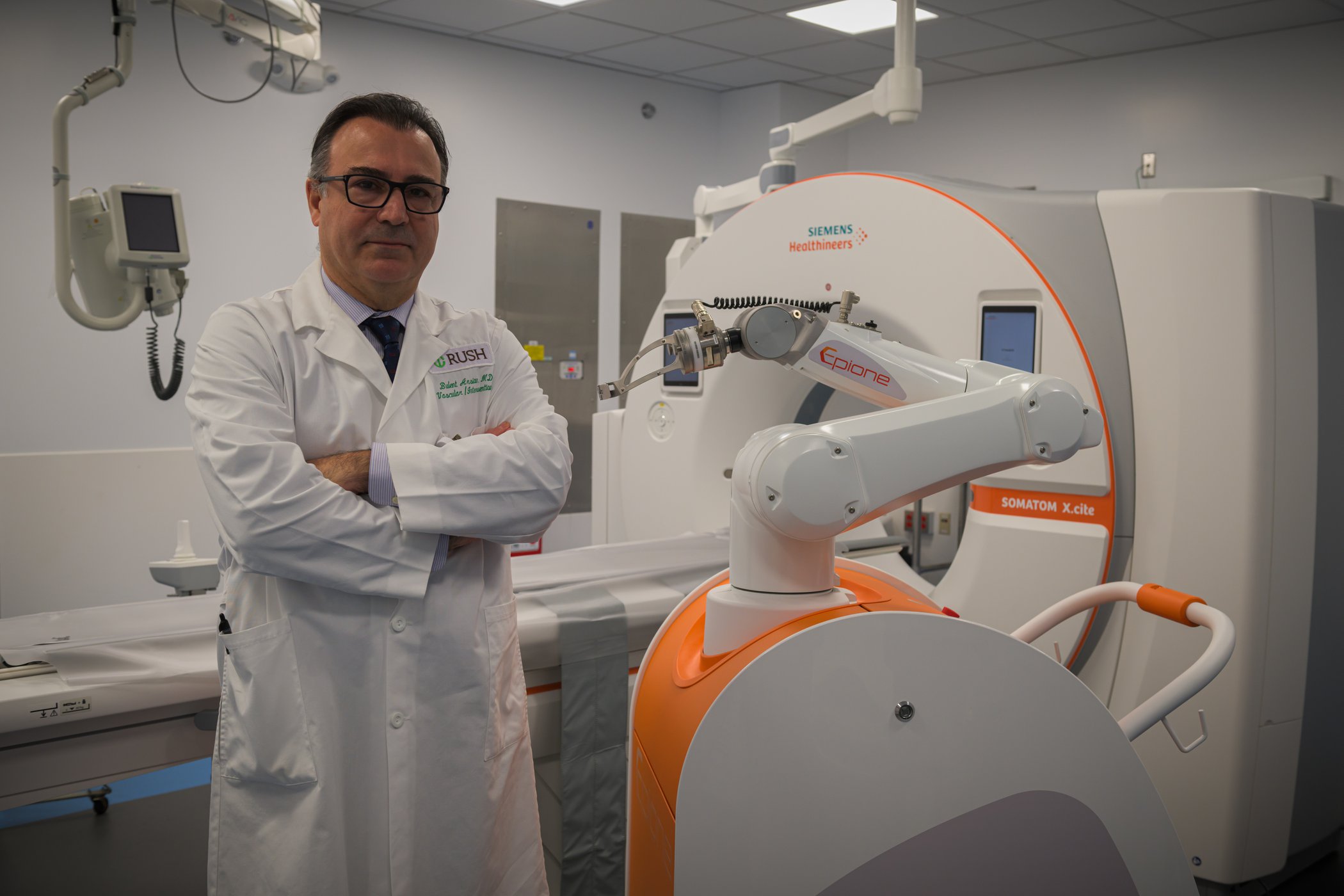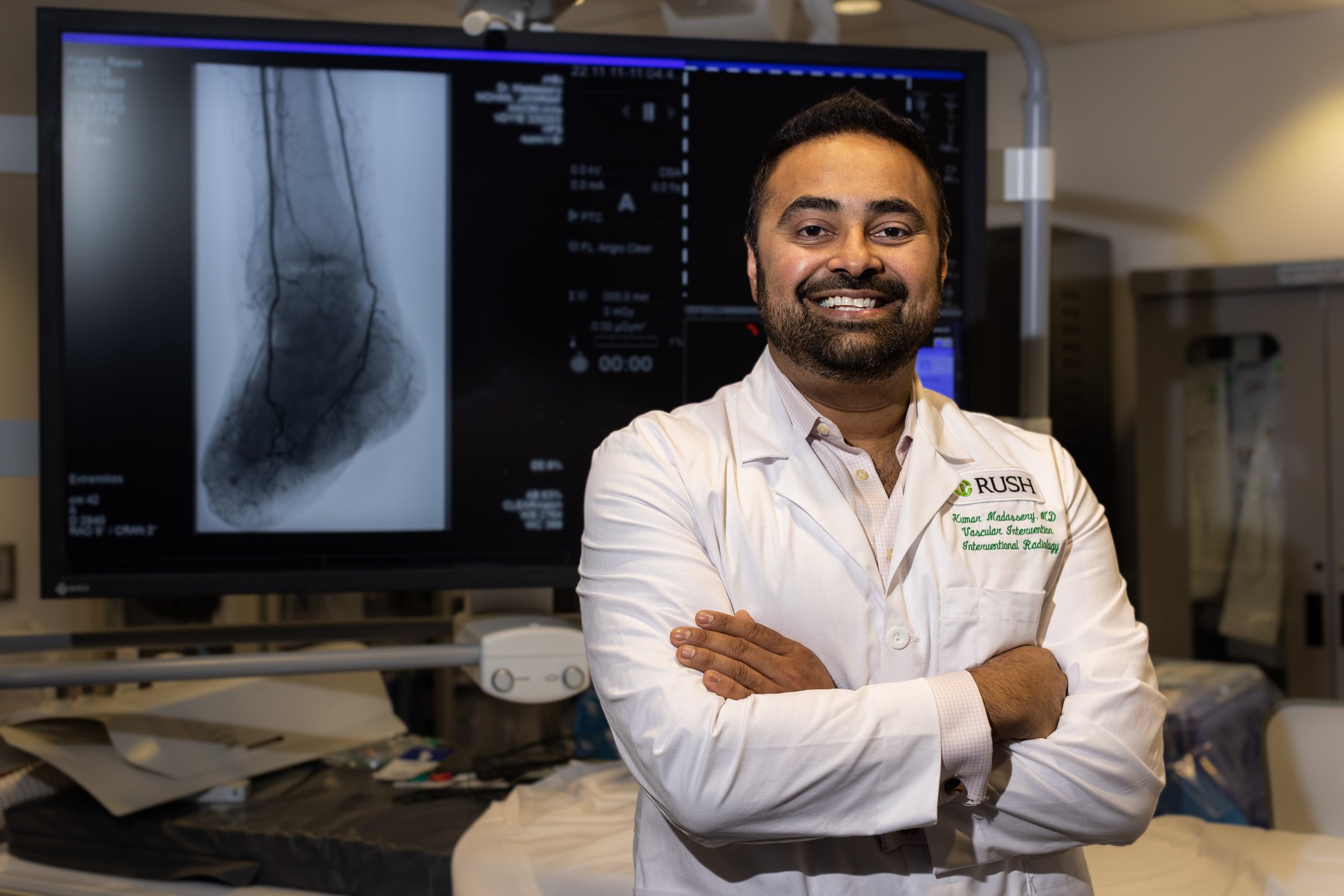The Rush roadmap
Creating an independent academic IR practice
Standing before a packed audience at the SIR 2024 Annual Scientific Meeting, Workshop Chair Bulent Arslan, MD, FSIR, didn’t mince words.
“Interventional radiology cannot thrive as an appendage of diagnostic radiology,” he said. “Our patients, our training, and our business model demand a clinical structure of our own.”
For Dr. Arslan, these weren’t just aspirational words—they were a reflection of more than a decade of work transforming the practice of interventional radiology (IR) at Rush University Medical Center in Chicago. In November 2024, Rush formally established the Department of Interventional Radiology, making it one of only three independent IR departments in the United States.
As of October 2025, Dr. Arslan—who had served as interim chair for 11 months—has been appointed the permanent inaugural chair, capping a journey that demonstrates how academic IR can evolve into a truly clinical specialty.
This article traces the steps that brought Rush IR to independence and offers a practical roadmap for other institutions seeking to follow the same path.

When the American Board of Medical Specialties (ABMS) recognized IR as a primary specialty in 2012, Dr. Arslan saw both validation and opportunity.
“The business model of IR is so different from that of diagnostic radiology,” he explained. “As clinicians, we can do more than treat the patients who are already in the hospital through other clinicians—we can bring in our own patients. Hospitals value that.”
At the time, IR at Rush functioned as a procedural service within radiology, operating a small vein clinic. To showcase its potential, Dr. Arslan and his colleagues began expanding.
“Before your IR group can become a formal department, it has to start acting like one,” he said.
They converted the vein clinic into a full interventional radiology ambulatory clinic, performing complex therapeutic procedures such as radioembolization, aortic and peripheral arterial interventions, advanced venous recanalizations, and spine procedures. They also developed disease-focused clinics for PAD, portal hypertension, embolization, and DVT/PE, which became the foundation for future growth.
Still, most patients were being referred and scheduled by other services. “It was almost like we were performing a CT scan that someone else ordered,” recalled Kumar Madassery, MD, FSIR, one of the department’s senior faculty. “We’d meet the patient right before the procedure and that was it.”
When scheduling problems and incomplete pre-procedure evaluations began affecting workflow, Dr. Arslan proposed a change.
“I told the hospital: ‘We can fix this, but we need to control the process. We need to see every patient the day before, review their labs, discuss what we’ll do, and prepare them for recovery.’”
That shift—creating a clinical consultation service—transformed the patient experience and streamlined care.
From service line to department
The success of the consult model quickly demonstrated IR’s value. By late 2022, Rush recognized interventional radiology as an independent service line and separated its operations from the Department of Diagnostic Radiology—a crucial intermediate step toward full departmental status.
Operations, research and education was controlled by IR only, but academic promotions, still required approval through radiology. “We had all the infrastructure but most of the autonomy” said Dr. Arslan.
In 2024, he made the case for full independence. The proposal emphasized that departmental status would allow IR to bring in its own patients, manage its clinical operations, and align with the hospital’s strategic goals in advanced procedural care. The plan—supported by clear financial data and demonstrated clinical value—was approved.
In November 2024, Rush officially launched the Department of Interventional Radiology, with Dr. Arslan named interim chair. Eleven months later, in October 2025, he formally accepted the position of permanent inaugural chair.

A clear road ahead
Space and staffing
The new department began with a solid but scalable foundation. It currently includes:
9 faculty FTEs (with approval for expansion as volume grows)
5 advanced practice providers (APPs)
5 integrated IR residents per year starting 2026 (total of 30 across the six-year program)
2 independent IR residents
1 advanced PAD fellow
The program operates across 7 dedicated interventional suites, plus a backup multispecialty suite and a growing clinic footprint. “About seven years ago, we were seeing roughly a thousand ambulatory patients a year,” said Dr. Madassery. “Now we see over 4,000 annually.”
Dr. Arslan emphasizes that growth must be balanced:
“It’s not just about increasing volume—it’s about aligning staffing, resources, and space to sustain high-quality patient care and financial performance.”
Visibility has also changed. “Now all surgical and medical teams see our fellows and attendings on the floors talking with patients,” he said. “That’s when people truly understood that IR is a clinical discipline.”
Scope of service
Today, Rush’s Department of Interventional Radiology performs nearly the entire spectrum of procedures in the IR domain—from PAD and aortic interventions to complex critical limb ischemia, oncologic embolization, Y-90, pain, and portal interventions.
The department also employs robotics and histotripsy, with active research protocols underway.
To help communicate this breadth, Rush’s marketing department partners closely with IR leadership.
We meet monthly to align outreach,” said Dr. Arslan. “We’ve run focused campaigns for histotripsy, critical limb ischemia, and prostate artery embolization in collaboration with urology. It’s made a huge difference in public and referring-physician awareness.”
Education and residency
Even before departmental independence, Dr. Arslan had already separated the IR residency program from diagnostic radiology. Rush now offers one of the nation’s largest IR training programs:
5 integrated residents per year (30 total once fully scaled)
2 independent residents
1 advanced PAD fellow
“With that many trainees available, we launched 24-hour in-hospital IR call coverage,” Dr. Arslan noted. “It not only improves patient care but also demonstrates our full clinical presence to the institution.”
Following the Rush IR roadmap
Dr. Arslan believes other academic institutions can follow a similar path if they first build the infrastructure—operations, faculty, education, and research—before seeking formal separation.
“Don’t look to your radiology department as your model,” he advised. “Look to the surgical departments. They’re the ones bringing in the same kind of revenue and providing the same kind of longitudinal care as we do.”
He stresses collaboration with diagnostic radiology leadership throughout the process. “When you frame it as a partnership—two departments supporting each other rather than one splitting off—it becomes a win-win.”
That philosophy has proven true at Rush. “The collaboration with diagnostic radiology is stronger than ever,” he said. “We each focus on what we do best, and the patients benefit most.”
Looking forward
The transformation at Rush did not happen overnight. It took strategic vision, transparent communication, and data-driven planning. But the results have validated the effort.
“Our success shows that when IR steps forward as a clinical specialty, everyone benefits—patients, hospitals, and the field itself,” said Dr. Arslan.
He adds with a laugh, “The only challenge now is me—keeping up with all the administrative work while still doing patient care. But I’m proud of what we’ve built and excited to see how far we—and others—can go.”
Rush IR Department Timeline
2012: ABMS approves interventional radiology as a primary specialty
2015: Rush IR operates a vein clinic within the Radiology Department
2017–2019: IR expands treatment services and ambulatory clinic
2020: IR adds consult service and begins building full clinical infrastructure
Nov 2022: IR recognized as an independent service line within Radiology
Jan 2024: SIR/ACR town hall: “DR and IR: Better Together or Apart?”
Mar 2024: SIR 2024 presentation: “IR can survive as an independent clinical practice: Yes or No?”
Nov 2024: Rush establishes the Department of Interventional Radiology; Dr. Arslan appointed interim chair
Oct 2025: Dr. Arslan named permanent inaugural chair; department continues to expand faculty and residency positions
